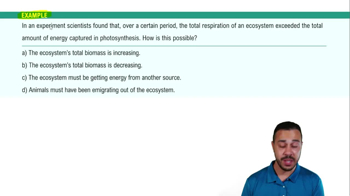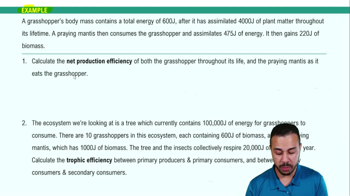Table of contents
- 1. Introduction to Biology2h 40m
- 2. Chemistry3h 40m
- 3. Water1h 26m
- 4. Biomolecules2h 23m
- 5. Cell Components2h 26m
- 6. The Membrane2h 31m
- 7. Energy and Metabolism2h 0m
- 8. Respiration2h 40m
- 9. Photosynthesis2h 49m
- 10. Cell Signaling59m
- 11. Cell Division2h 47m
- 12. Meiosis2h 0m
- 13. Mendelian Genetics4h 41m
- Introduction to Mendel's Experiments7m
- Genotype vs. Phenotype17m
- Punnett Squares13m
- Mendel's Experiments26m
- Mendel's Laws18m
- Monohybrid Crosses16m
- Test Crosses14m
- Dihybrid Crosses20m
- Punnett Square Probability26m
- Incomplete Dominance vs. Codominance20m
- Epistasis7m
- Non-Mendelian Genetics12m
- Pedigrees6m
- Autosomal Inheritance21m
- Sex-Linked Inheritance43m
- X-Inactivation9m
- 14. DNA Synthesis2h 27m
- 15. Gene Expression3h 20m
- 16. Regulation of Expression3h 31m
- Introduction to Regulation of Gene Expression13m
- Prokaryotic Gene Regulation via Operons27m
- The Lac Operon21m
- Glucose's Impact on Lac Operon25m
- The Trp Operon20m
- Review of the Lac Operon & Trp Operon11m
- Introduction to Eukaryotic Gene Regulation9m
- Eukaryotic Chromatin Modifications16m
- Eukaryotic Transcriptional Control22m
- Eukaryotic Post-Transcriptional Regulation28m
- Eukaryotic Post-Translational Regulation13m
- 17. Viruses37m
- 18. Biotechnology2h 58m
- 19. Genomics17m
- 20. Development1h 5m
- 21. Evolution3h 1m
- 22. Evolution of Populations3h 52m
- 23. Speciation1h 37m
- 24. History of Life on Earth2h 6m
- 25. Phylogeny2h 31m
- 26. Prokaryotes4h 59m
- 27. Protists1h 12m
- 28. Plants1h 22m
- 29. Fungi36m
- 30. Overview of Animals34m
- 31. Invertebrates1h 2m
- 32. Vertebrates50m
- 33. Plant Anatomy1h 3m
- 34. Vascular Plant Transport2m
- 35. Soil37m
- 36. Plant Reproduction47m
- 37. Plant Sensation and Response1h 9m
- 38. Animal Form and Function1h 19m
- 39. Digestive System10m
- 40. Circulatory System1h 57m
- 41. Immune System1h 12m
- 42. Osmoregulation and Excretion50m
- 43. Endocrine System4m
- 44. Animal Reproduction2m
- 45. Nervous System55m
- 46. Sensory Systems46m
- 47. Muscle Systems23m
- 48. Ecology3h 11m
- Introduction to Ecology20m
- Biogeography14m
- Earth's Climate Patterns50m
- Introduction to Terrestrial Biomes10m
- Terrestrial Biomes: Near Equator13m
- Terrestrial Biomes: Temperate Regions10m
- Terrestrial Biomes: Northern Regions15m
- Introduction to Aquatic Biomes27m
- Freshwater Aquatic Biomes14m
- Marine Aquatic Biomes13m
- 49. Animal Behavior28m
- 50. Population Ecology3h 41m
- Introduction to Population Ecology28m
- Population Sampling Methods23m
- Life History12m
- Population Demography17m
- Factors Limiting Population Growth14m
- Introduction to Population Growth Models22m
- Linear Population Growth6m
- Exponential Population Growth29m
- Logistic Population Growth32m
- r/K Selection10m
- The Human Population22m
- 51. Community Ecology2h 46m
- Introduction to Community Ecology2m
- Introduction to Community Interactions9m
- Community Interactions: Competition (-/-)38m
- Community Interactions: Exploitation (+/-)23m
- Community Interactions: Mutualism (+/+) & Commensalism (+/0)9m
- Community Structure35m
- Community Dynamics26m
- Geographic Impact on Communities21m
- 52. Ecosystems2h 36m
- 53. Conservation Biology24m
48. Ecology
Introduction to Ecology
Problem 10a
Textbook Question
In an ecosystem, how is the flow of energy similar to that of matter, and how is it different?
 Verified step by step guidance
Verified step by step guidance1
Identify the components of an ecosystem involved in the flow of energy and matter, such as producers, consumers, and decomposers.
Understand that energy in an ecosystem flows in a linear pathway, primarily entering through sunlight and moving through trophic levels from producers to various levels of consumers and finally to decomposers.
Recognize that matter cycles within an ecosystem, being reused and recycled between the biotic (living organisms) and abiotic (non-living elements like water, air, and soil) components.
Examine how energy flow is unidirectional, meaning once energy is transferred between trophic levels, it cannot be reused by the ecosystem, whereas matter is continuously recycled and reused within the ecosystem.
Explore the efficiency of energy transfer, which is typically around 10% from one trophic level to the next, leading to a decrease in available energy at higher trophic levels, while matter can be broken down and reassembled in new forms without such loss of efficiency.
Recommended similar problem, with video answer:
 Verified Solution
Verified SolutionThis video solution was recommended by our tutors as helpful for the problem above
Video duration:
2mPlay a video:
Was this helpful?
Key Concepts
Here are the essential concepts you must grasp in order to answer the question correctly.
Energy Flow in Ecosystems
Energy flow in ecosystems refers to the transfer of energy through various trophic levels, starting from producers to consumers and decomposers. This flow is unidirectional, meaning energy enters the ecosystem through sunlight, is converted by plants into chemical energy via photosynthesis, and is eventually lost as heat. Understanding this flow is crucial for grasping how ecosystems function and maintain balance.
Recommended video:
Guided course

Energy Flow Through Ecosystems Example 1
Matter Cycling in Ecosystems
Matter cycling involves the continuous movement of nutrients and elements through biotic and abiotic components of an ecosystem. Unlike energy, matter is recycled; it is taken up by organisms, transformed, and returned to the environment through processes like decomposition. This cycling is essential for sustaining life, as it ensures the availability of necessary nutrients for organisms.
Recommended video:
Guided course

Ecosystems, Energy, and Matter
Differences Between Energy Flow and Matter Cycling
The primary difference between energy flow and matter cycling lies in their directionality and permanence. Energy flows in one direction and is eventually lost as heat, while matter is recycled and reused within the ecosystem. This distinction highlights the importance of energy input from the sun for ecosystem function, contrasted with the closed-loop nature of nutrient availability through matter cycling.
Recommended video:
Guided course

Energy Flow Through Ecosystems Example 2

 2:54m
2:54mWatch next
Master What is Ecology? with a bite sized video explanation from Jason Amores Sumpter
Start learningRelated Videos
Related Practice































































































